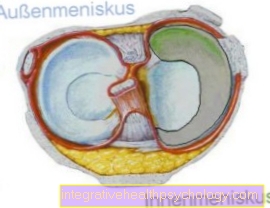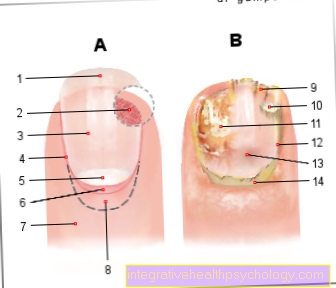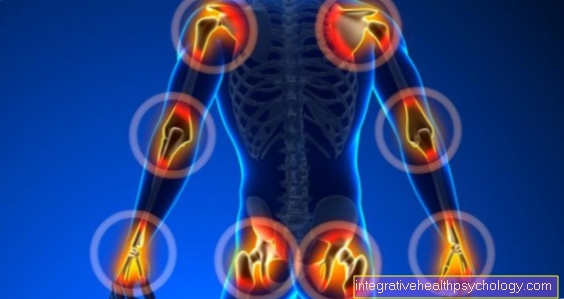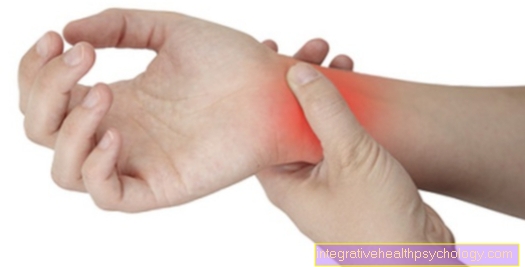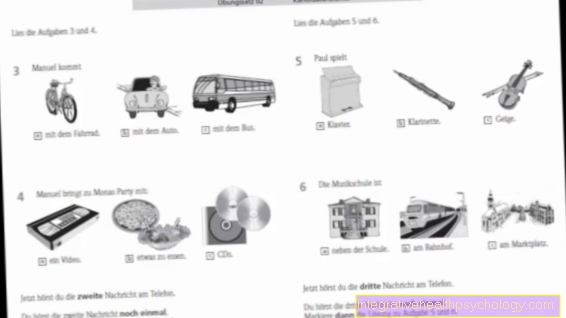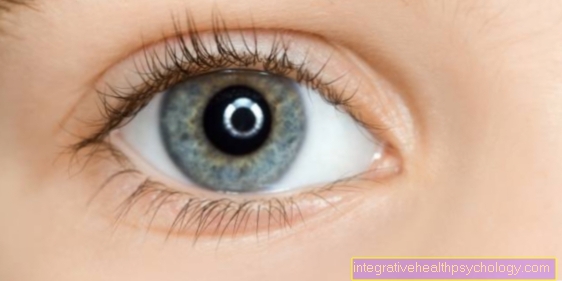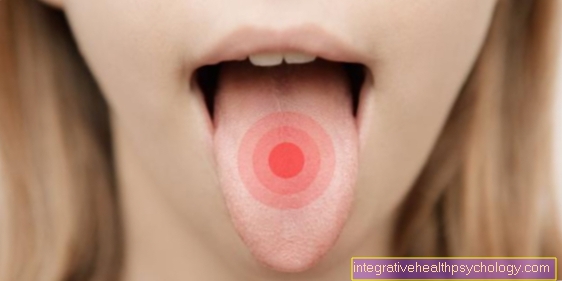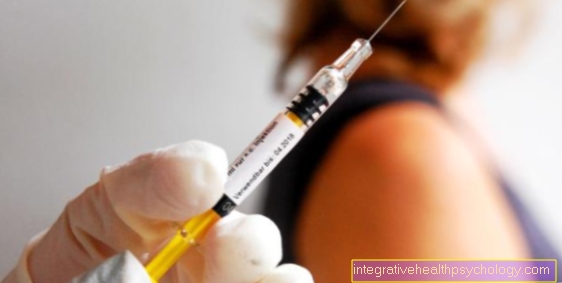Synaptic cleft
definition
The synaptic gap is a space between two communicating nerve cells, which is involved in the transmission of action potentials (Nerve impulses) plays an important role. A modulation of the signal transmission takes place in it, which is of great pharmacological importance.

Creation of a synaptic gap
A synapse is that Transition between two nerve cells or one Nerve cell and a muscle cell. The latter is and is a special form of the synapse motorized end plate called.
Read more about the topic here: motorized end plate
What is important, however, is that between the two cells no direct contact exists, i.e. there is an interruption, which is called the synaptic gap.
Be about nerve cells electrical signals headed to then for example a to excite other nerve cells or muscle cells. An excited nerve cell in turn passes the signal on while an excited muscle contracts.
Since, as already described, there is no direct contact between the cells, the signal has to cross the gap in a different way. This is done using Messenger substances, also Neurotransmitters called, e.g. Acetylcholine, Serotonin or Dopamine.
Transmitters are stored in the first nerve cell, i.e. the one from which the signal comes from, in so-called vesicles, i.e. small bubbles.
You can find out more about the topic here: Neurotransmitters
If an electrical excitation (i.e. a signal) arrives, these messenger substances are released from the presynaptic membrane (cell membrane of the first nerve cell) and diffuse to the postsynaptic membrane (cell membrane of the second nerve or muscle cell), to which the signal is transmitted.
Here the transmitters can bind to certain receptors on the postsynaptic membrane and initiate excitation.
Functions of a synaptic cleft
As already described, synapses serve to transfer excitation from one cell to the next. Due to the structure already described, however, the signal transfer only works in one direction: pre-synapse to post-synapse. A retrograde line is therefore not possible and the flow of information is directed.
However, it is also important that there are not only excitatory synapses, but also so-called inhibiting ones. Here the presynaptic neuron (nerve cell) releases transmitters that do not excite the following neuron, but inhibit it.
Find out more about electrical excitation here: Action potentials
How chemical synapses work
Whenever one Nerve cell sending a signal to a muscle- , Glands-, or other nerve cell sends out, the transfer takes place over the synaptic gap, this is only approx. 20-30 nanometers wide.
The lengths Processes of the nerve cells (also "Axons"Called") conduct the nerve impulse (i.e. the "Action potential“) From the center of the nerve cell to the target cell. The synaptic gap is located between the axon and the target cell (for example a muscle cell). At the presynaptic membrane - So the membrane, which is located at the end of the axon, now pour so-called synaptic vesicles (Vesicle) a Neurotransmitters into the synaptic cleft.
At the other end of the synaptic gap, in our example, there is a muscle cell with a postsynaptic membrane - a membrane that lies after the synaptic gap. In it are Receptorswho pass on the action potential as soon as the Neurotransmitter binds to them.
A friend Neurotransmitters Is for example Dopamine (known from the drug cocaine!).
As soon as enough action potentials have been created on the postsynaptic membrane, the muscle cell reacts and contracts. It is the same with gland cells or other nerve cells. This signal transmission takes place within fewer milliseconds.
At electrical synapses the transfer takes place without chemical modeling directly via electrical impulses.
Neurotransmitters
Neurotransmitters are messenger substances that are a Forward signal from one nerve cell to another.
The forwarded signal can be either a activation as well as one inhibition be the next nerve cell. This depends on which messenger substance is involved and which receptors are present on the postsynaptic membrane of the second nerve cell.
There are many different types of neurotransmitters that can act in both the central and peripheral nervous systems.
You can find out more about the topic here: Neurotransmitters
Acetylcholine
Acetylcholine is a very important messenger substance of the human body. It serves as a on many synapses Transmitter, both in central nervous system, which includes the brain and spinal cord, as well as im peripheral nervous systemwhich includes the entire nervous system except the central one.
Acetylcholine has two important functions in the periphery. On the one hand, it is the messenger substance that drives them Transfer of excitation from the nerve cell to the muscle does.
On the other hand, it serves the Transmission of signals in the autonomic nervous system, the autonomic nervous system, which controls functions such as digestion or sweat secretion, i.e. processes that we cannot consciously control.
Read more about the topic here: Acetylcholine
Dopamine
Dopamine is a Transmitter, especially in the central nervous system plays a role plays. For one thing, it's up to the Movement initiation and -Coordination involved.
A demise of certain dopamine-producing nerve cells makes itself for example in the form of Parkinson's disease (Parkinson's disease) noticeable.
It also has an important function in the Motivational and Drive formation.
Combined with Norepinephrine it also has a happiness-increasing effect. It is therefore also known as one of the "Happiness hormones" designated.
In the rest of the body, it has an effect similar to that of adrenaline or. Norepinephrinefor example by using the Blood pressure increased. In certain doses elevated it the Blood flow to the abdominal viscera including the kidneys.
Simplified illustration
For a better understanding in the following a pictorial representation:
A group walker (=Action potentials) would like with boats (=synaptic vesicles) to cross a river(=synaptic gap), but there are only one docking or dropping point per side (= pre- & postsynaptic membrane).
When they have successfully crossed the river, they can Continue hiking on the other side of the river (= Forwarding to the target cell). Of course, the jetty can be on the other side of the river already be occupied, or the Current is too strong, then the hikers would capsize or not even arrive. That would be the one, so to speak Effect of medication or drugs, because these intervene in the signal transmission process in the synaptic gap by Block pre- or postsynaptic membrane.
Modulation by medication and drugs
The synaptic cleft offers many possibilities of Manipulation through medication or drugs.
A well-known group of active substances from Antidepressants, the so-called Selective Serotonin Reuptake Inhibitors (short: SSRI) inhibit, for example Resumption of the messenger substance serotonin on the presynaptic membrane. As a result, serotonin remains permanently in the synaptic gap, and the postsynaptic membrane is continuously excited - So constantly sends signals to the next cell. Only when the effect of the drug wears off can the serotonin disappear again from the synaptic gap.
It therefore has an effect similar to cocaine - only that cocaine is not limited to the messenger substance serotonin, but also that Blocked reuptake of dopamine and norepinephrine. So that's it not selective, and above all very difficult to control, after all, two of the three will be Catecholamines influenced in the body.(In addition, cocaine is not subject to any pharmacological control and can have a very different intensity of action ...)
The three catecholamines adrenaline, Norepinephrine and Dopamine are messenger substances that are involved in Escape and stressful situations be distributed. This also explains the effects of cocaine: sweat, Excitement, nervousness, but also euphoria and increased efficiency. Overdose go with aggressiveness , paranoia, Hallucinations and Cardiac arrhythmias up to cardiac arrest hand in hand. After consumption there is usually a so-called Crash phasein which depression-like states occur.
The synaptic gap is therefore a popular starting point for Pharmaceuticals, especially in the neurology, anesthesia and psychiatry.
The duration of the effect depends on the group of active ingredients and the chemical properties of the drug. Long-acting benzodiazepines work up to 3 days, others only a few hours.
nicotine
The nicotinewhich is the drug of tobacco is also a Transmitter, which can occupy receptors in the human body and thus excite nerve cells, e.g. the nicotinic acetylcholine receptorwhich, as the name suggests, can be activated by nicotine and acetylcholine.
In the central nervous system, this leads to nicotine Activation of the reward system - the consumer feels happy and well. This is one of the Addictive components the drug.
In the nervous system of the Gastrointestinal tract it can also be a activating effect to have.
Read more about the topic here: nicotine







